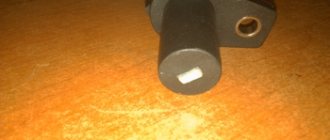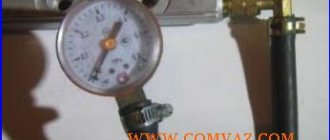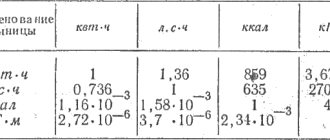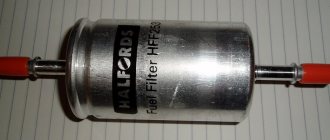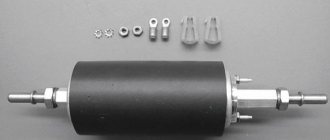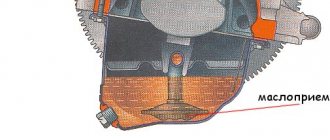Fuel system pressure regulator and its functions
The main function of the RTD is to maintain the operating pressure of the fuel, which is supplied by the fuel pump to the injectors at given engine operating conditions.
On passenger cars, one of two types of regulator is installed:
- mechanical - a device operating on the principle of a bypass valve;
- electric - the functionality is similar to that of a pressure sensor in the fuel system. Transmits information to the electronic control unit, which in turn regulates fuel consumption using feedback.
Let's consider a mechanical fuel pressure regulator, which is used on our domestic injection Zhiguli of the seventh model.
The electronic control unit has no direct influence on the regulator. This is one of the few elements of the fuel system that is controlled by changing the air pressure in the intake manifold.
The regulator is made as a cylindrical body, from which three tubes emerge. The tube at one end is connected by a hose to the vacuum cavity of the engine, the other, side - to the fuel rail (the tube goes into the ramp) and the third from the other end - to the return pipeline ("return") through a fitting. Inside, the cavity is divided by a membrane into two compartments: fuel and vacuum. Fuel enters the fuel compartment from the ramp and exits (depending on the specified operating mode) into the “return” through a bypass valve connected to the membrane. In the vacuum compartment there is a spring acting on the membrane, which ensures the operation of the valve.
Causes and Troubleshooting
If the above symptoms are detected, you should check the performance of the RTD using one of the suggested methods:
- measure the pressure in the fuel rail, its value should be at least 3 bar;
- find the return hose and carefully press it with pliers while the engine is running;
- disconnect the vacuum pipe leading from the manifold from the regulator.
The most reliable way is to measure with a pressure gauge. The device is connected to the fitting on the fuel rail, the test is performed with the engine running. If the pressure is below 3 Bar, additionally check the fuel pump - the unit may have lost performance. For diagnostics, you will need a tee with a pressure gauge embedded in the supply line. If the pump produces 3 Bar or more, change the RTD.
The reasons for valve failure look like this:
- the spring has lost its elasticity and allows the membrane to bypass fuel at low pressure;
- pollution with low-quality gasoline;
- rod jamming.
Due to the design features (the element body is rolled), repairing the fuel pressure regulator is impossible in most cases; the part will have to be replaced. The option of washing and blowing helps only with blockages inside the element.
Squeezing the return line is done at idle speed of the engine, preferably “cold”. If engine performance stabilizes, there is a problem with the RTD or pump. To determine the “culprit”, you will still need to measure the supply pressure. Try removing the vacuum tube from the manifold at higher speeds - if the valve has become unusable, the behavior of the power unit will not change.
RTD device
While the engine is running, the pump constantly supplies fuel under pressure from the gas tank through the line through filters into the fuel rail. From there, through the connection, gasoline fills the fuel cavity of the regulator and acts on the membrane. From the side of the vacuum cavity, the membrane partition is acted upon by a total pressure consisting of the spring pressure and the pressure (vacuum) inside the suction manifold. If the pressure inside the fuel chamber is higher than the pressure in the vacuum chamber, the bypass valve opens and discharges part of the fuel into the return line. Thereby, regulating the portion of fuel to the injectors at a given moment in the operation of the power unit.
Location of the RTD in the fuel rail of the vehicle
The use of a special regulator for the fuel system is associated with the need to reduce or increase the pressure of fuel supply to the engine when it operates at different speeds. For example, idling requires a very small amount of fuel, while as the speed increases, the intensity of its injection should increase.
In order to equalize this difference on all injectors, the device is installed at the end of the fuel rail. As standard, it is mounted in the fuel rail. Very often, its location can be changed - for example, the RTD is placed in a return hose or even in a tank.
Placement in the gas tank makes it possible to avoid the need to install additional fuel lines, and the check valve blocks excess fuel from entering the system. Regardless of the location, the RTD performs the same function, which is to support the fuel pressure required and safe for the vehicle engine.
For systems without fuel recirculation, the RTD is located in the fuel tank and is designed to maintain the same fluid pressure relative to atmospheric pressure. The specificity of this arrangement is that the differences between the fuel pressures in the tank and in the intake manifold will not be constant, which is ultimately taken into account in the duration of injection of the working fluid.
RTD installation location
Devices for regulating fuel pressure in the engine power system are installed in one of three places:
- Directly on the engine.
- On the fuel line.
- In the fuel tank.
The placement largely depends on the type of product and the layout of the gas pipeline system.
The mechanical RTD is installed directly on the fuel rail.
In this case, the fuel line connecting the tank to the engine has two lines. The first supplies gasoline to the engine, the second sends excess gasoline back into the tank through the regulator.
In a system with an electric pressure regulator, there is no fuel recirculation. It is used less frequently, but has the advantage that it only has a discharge pipeline.
This simplifies the design of the system and reduces the heating of gasoline (less evaporates). With this power supply scheme, the fuel pressure is adjusted before it enters the ramp. The device is installed immediately behind the fuel pump in the tank or crashes into the fuel line.
Operating principle of RTD
The valve design and operating principle depend on the type of fuel system of a particular vehicle. There are 3 ways to supply gasoline from the tank to the injectors:
- The pump together with the regulator is installed inside the tank; fuel is supplied to the engine through one line.
- Gasoline is supplied through one tube and returned through another. The fuel system check valve is located on the distribution rail.
- The circuit without a mechanical regulator provides for electronic control of the fuel pump directly. The system contains a special sensor that registers pressure; the pump performance is regulated by the controller.
In the first case, the return flow is very short, since the valve and electric pump are interlocked into a single unit. The RTD, located immediately after the supercharger, dumps excess gasoline into the tank, and the required pressure is maintained throughout the supply line.
Reference. The first scheme with a regulator inside the gas tank has been implemented on all Russian-made VAZ cars.
The second option is used in most foreign cars. A valve built into the fuel rail allows excess fuel to flow into the return line leading to the tank. That is, 2 gasoline pipes are laid to the power unit.
There is no point in considering the third circuit - instead of a regulator, there is a sensor whose functionality is checked using a computer connected to the diagnostic connector.
We recommend: Types of fuel additives
A simple fuel pressure valve installed in the fuel pump unit consists of the following elements:
- cylindrical body with pipes for connecting the supply and return lines;
- a membrane connected to a locking rod;
- valve seat;
- spring.
The amount of pressure in the supply line depends on the elasticity of the spring . While most of the fuel goes into the cylinders (high load on the engine), it keeps the membrane and valve stem closed. When the crankshaft speed and gasoline consumption decrease, the pressure in the network increases, the spring compresses and the membrane opens the valve. The fuel begins to be discharged into the return line, and from there into the gas tank.
The fuel pressure regulator installed in the rail operates on a similar principle, but reacts faster to changes in load and gasoline consumption. This is facilitated by connecting an additional pipe of the element to the intake manifold. The higher the crankshaft speed and the vacuum on the spring side, the stronger the membrane presses the rod and closes the passage of fuel into the return line. When the load decreases and the speed drops, the vacuum decreases and the rod releases - the return flow opens and excess gasoline begins to be discharged into the tank.
How to find out if the fuel pressure regulator is faulty
In preparing the air-fuel mixture, when the power unit operates in specified modes, all components of the engine power system are involved to one degree or another. The failure of one element during diagnosis may erroneously indicate the failure of another. Also, RTDs have few obvious signs of malfunction. More often they may be similar to unstable fuel supply from the pump, failure of any sensor in the system, clogged filter, etc. But with a high degree of probability that the regulator is faulty, the following signs are suitable:
- at idle speed the engine operates unstably intermittently or stalls;
- the dynamics of the car have deteriorated during its operation;
- high gasoline consumption;
- the engine is difficult to start after a long period of parking;
- the motor does not develop the required power, especially when driving uphill or under load;
- when operating the car, jerking is felt;
- when over-gasping, failures in engine operation occur;
- a distinct smell of gasoline in the cabin and, especially under the hood, caused by fuel leakage in the connections of the main hoses (even when changing clamps and hoses).
Reasons for failure of the fuel pressure sensor
There are actually few reasons for the failure of the fuel pressure sensor. This is either damage to the internal parts of the sensor or its wiring. In the first case, this may be mechanical damage to the body, its rusting due to mechanical damage or simple old age. It may also damage any electrical contact inside the sensor. As a rule, it cannot be repaired and must be replaced.
However, more often than not, it is not the sensor itself that is damaged, but its signal wiring or connection connector (the so-called “chip”). In some cases, it is noted that under the influence of vibration, wires fray, their insulation deteriorates, and a short circuit may even occur, which can cause the engine to stall while driving. In this case, it is necessary to perform additional diagnostics and replace the wiring and/or connector that fits onto the sensor.
As for the mechanical fuel pressure control valve, it can simply allow a certain amount of fuel to pass through, which is why there will be low pressure in the system with all the ensuing consequences, in particular, a drop in engine power, “twitching” of the car and other troubles.
Types of RTD faults
Judging by the appearance of a mechanical fuel pressure regulator, there is nothing to break in it. But still, this is a mechanism consisting of many parts, which during long-term use are subject to wear, corrosion and “fatigue”. There may also be a defect in the manufacture of this device.
The main reasons that lead to malfunction of the regulator:
- The shut-off valve does not maintain the required pressure in the cavity. If we take into account only the regulator, then the cause may be a spring (burst, sagged) that does not provide sufficient force when acting on the valve. As a result, the fuel that should be supplied to the injectors leaks into the “return”, and the engine is difficult to start, does not develop enough power, has poor dynamics, etc.
- It happens that the valve, in the given engine operating modes, fits tightly to the hole and does not allow gasoline to flow into the return line. The reason may be low-quality fuel, a long period of idle time of the car, corrosion of the material, which is why the valve is “stuck” to the socket. With such a malfunction, the pressure in the fuel rail increases, the spark plugs may flood, the safety valve is triggered, or leaks appear in the system connections.
- The shut-off valve “wedges” during operation, that is, the pressure in the ramp does not change evenly, with a delay from the specified parameters. The reason is usually poor quality fuel, dirt, corrosion, etc. At this time, the car cannot be accelerated; it begins to twitch. When parked without load, the idle speed “floats”.
Signs of device malfunction
The valve is operated at an intense rhythm. Long-term loads affect its performance. It is necessary to promptly identify the symptom of a malfunction of the fuel pressure regulator in order to replace it. Failures and malfunctions are determined in most cases by indirect signs. Such factors include the following phenomena:
- fuel consumption increases;
- the power characteristics of the internal combustion engine are deteriorating;
- the power plant loses stability at idle;
- dips occur or jerks appear when switching speed modes;
- the car responds inadequately to pressing the gas pedal.
Checking the fuel pressure regulator often begins with determining the quality of the springs. As the device is used, their hardness decreases. This phenomenon negatively affects performance, in particular, the valve opens earlier than the operating cycle requires.
The result of a drop in rigidity is that fuel is sent to the tank in larger quantities than intended by the designers. At the same time, the pressure in the system decreases, and the engine loses efficiency and power. If there is a design possibility, then the weak spring is replaced.
We recommend: ECM: what is it in a car
The low quality of domestic fuel also has a negative impact on the functioning. As a result, the membrane becomes clogged, after which it cannot close partially or completely. As a result, the fuel pressure in the system also drops, which leads to negative phenomena.
You can get rid of mechanical blockages by cleaning. This is carried out if the design of the device allows. It is worth considering that repairing the fuel pressure regulator does not always save users. This happens when there is significant wear or wear on the valve as a whole or its individual parts. It is not always possible to restore the element to full operation.
There are cases when the RTD becomes jammed. In this case, the engine simply stalls, and at the same time fuel begins to flow from poorly sealed joints. Here, repairs are unpromising; all that remains is a complete replacement of the unit with a new one. If this happens, then it is worth changing the gas station or not refueling at dubious gas stations in advance; it is also worth checking the functionality of the fuel filter, which has failed to be properly cleaned.
Partial loss of valve functionality often occurs. In such a situation, the engine operates jerkily, which the driver feels very well while operating the car. Sometimes passengers feel them too. Timely cleaning of passages will be relevant, restoring the product’s functionality .
An electronic device is less sensitive to the quality of gasoline. It is also little influenced by mechanical factors. However, it is not without its shortcomings, weaknesses and characteristic vulnerabilities. But if you avoid situations with low-quality fuel, you can largely avoid loss of regulator functionality.
RTD flushing
Structurally, fuel pressure regulators are mostly non-separable. Therefore, if they break down, you should not try to disassemble and repair them, it is better to replace them. But don’t rush to throw them away; you can try cleaning and rinsing the device.
To give the regulator a “bath”, you should prepare an old toothbrush, a special carburetor cleaner or the well-known WD-40 spray, and a rag.
After dismantling the RTD, remove the rubber seal from the fuel supply pipe from the ramp. Place the regulator in a small container and fill it with liquid to clean carburetors. Let it “lie” there for a few minutes. Next, we take it out and clean it with a toothbrush, where possible, after that we blow it, dry it with air under pressure using a compressor.
In the same way, washing is done with a spray, only WD-40 is poured into both cavities directly from the can, dried and blown with compressed air.
At service stations there are ultrasonic units for washing nozzles, with which you can thoroughly clean the regulator of all contaminants. This procedure is expensive; you should compare the price of RDT with the price of ultrasonic cleaning.
Self-check and replacement of the pressure regulator
Before removing and washing the pressure regulator, you should make sure that this is the cause. You can check whether the device works or not at home in the garage.
To do this, you need a pressure gauge (a tire gauge will do), a small piece of oil-resistant hose (according to the diameter of the pressure gauge tube) and clamps to ensure a tight connection.
The mechanical regulator can be checked in the following order:
- There is a pressure relief fitting in the fuel rail; you need to remove the protective cap from it (the engine is turned off).
- Next, release the pressure in the rail by pressing the spool located in the fitting, then unscrew it.
- We assemble a device for measuring pressure. We pull the hose with one side onto the pressure gauge tube, the other side onto the spool fitting and tighten it with clamps.
- We start the engine and let it run for a while without load at minimum speed.
- With a working regulator, the pressure in the ramp of a 1.5-liter Zhiguli engine should fall within the range of 2.9 to 3.3 kgf/sq.cm (for other brands of cars, data is in the passport).
- Next, remove the vacuum hose from the regulator nozzle; the pressure should increase by 0.2 - 0.7 kgf/sq.cm to the previous one.
- We put the vacuum hose in place and turn off the engine. The pressure should drop slightly and remain in the system for up to two hours.
If during testing the specified parameters are maintained, then the RTD is in good condition; if not, it needs to be replaced.
The cause of the pressure discrepancy may be a malfunction of the fuel pump, a clogged pipeline or filter, etc. After making sure the filter is clean, you should start with the fuel pressure regulator.
To replace the regulator you will need a 24 mm wrench and a 5 mm hexagon. The replacement procedure is as follows:
- unscrew the nut of the “return” fitting on the RTD;
- loosen and remove the vacuum hose from the regulator;
- Use a hexagon to unscrew the screws securing the regulator body to the rack;
- Carefully remove the mechanical RTD from the fuel rail.
Installation is not difficult, all operations are repeated in reverse order. It should be remembered that a rubber O-ring is installed on the pipe that enters the ramp. The work is carried out on a cold engine with preliminary release of pressure in the fuel system.
